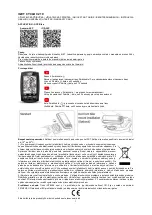
WARNING:
Do not over tighten the stem bolt. Over tightening the stem bolt can
damage the steering system and cause a loss of control.
If necessary re-adjust the handlebar and tighten the handlebar clamp nut.
WARNING:
If the handlebar clamp is not tight enough, the handlebar can slip in
the stem. This can cause damage to the handlebar or stem, and can cause loss of control
and serious injury or even death.
The handlebar may not already be installed on your bike from the factory. In that
case you may need to install the handlebars onto the stem itself. Remove the
stem faceplate/top plate by loosening and removing the front bolts (either 2 or
4 depending on which style comes on your bike). Place the handlebar into the
stem with the brake lever(s) facing forward. Make sure the cables are not tangled
and track smoothly on either side of the stem. Place the stem faceplate over the
handlebar, and replace the 2 or 4 bolts to secure the faceplate.
On a 2 bolt stem faceplate alternate tightening the stem bolts making sure the
space between the faceplate and stem is even on both sides. (See Figure 1.)
On a 4 bolt stem faceplate, follow the cross tightening pattern shown, making
sure the bolts are tightened evenly. (See Figure 2.)
5. TESTING HANDLEBAR AND STEM TIGHTNESS
To test the tightness of the stem, straddle the front wheel between your legs tightly
and try to turn the handlebar back and forth. The handlebar should not slip or move
independently of the front wheel at all. If the handlebar does move, re-align the
stem with the front wheel and tighten the stem bolt. Re-test to make sure the stem
is secure with the same process.
To test the tightness of the handlebar, hold the bike stationary and try to move the
ends of the handlebar up and down or forward and back. If the handlebar moves,
loosen the handlebar clamp nut or bolts evenly to re-position and then re-tighten.
Repeat the test until the bars will not move.
2
1
17
C
















































